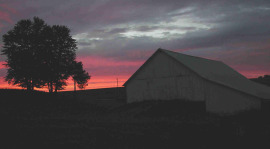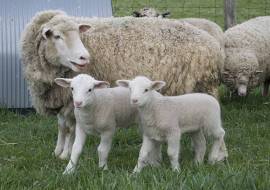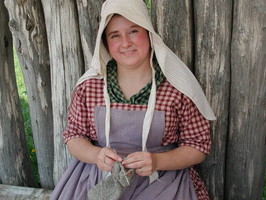
My Sheep's 19th Century Lifestyle
 My barn as the sun is setting. The sheep live in the lower level and hay is stored in the upper level.
My barn as the sun is setting. The sheep live in the lower level and hay is stored in the upper level.
While shepherding has become more advanced with man-made feeds and feed-lots, year-round breeding, and growth hormones, I choose to raise my little woolen friends as traditionally as
possible. My sheep live a life not much different than their ancestors would have found on a 19th century farm.
Sheep were designed to eat grass, and mine do – grass that they forage for themselves in a big pasture with plenty of sunshine and dotted with the shade of stately old trees. In the winter when
the pasture is resting under a protective layer of snow, they eat grass hay. They always have access to a hand-made wood barn and can choose to be in the barn or in the pasture at their
will. I’ve noticed that the cold doesn’t seem to bother them at all, but they hate rain, and will not walk through snow!
The natural lifecyle of a ewe is to breed in the fall and lamb in the spring (gestation is five months). Modern breeds are designed to breed out of season. It is more profitable to
remove the lambs from their mothers so that the ewe can become pregnant again as soon as possible. But that’s not what I do. My lambs stay with their mothers and are weaned slowly at the
discretion of their own mamas. As a result I only breed my ewes once a year, and I feel they deserve the rest. Who wants to be barefoot and pregnant all the time?
My ewes are bred using the, um, traditional method. No artificial insemination. The ram spends the summer and early fall separated from the ewes. Then between Thanksgiving and
Christmas I open the gate and let him in with the ladies. Lambs are born in the spring so they have the lovely long spring and summer days to enjoy as they grow.
It is not the most profitable way to raise sheep, but it is a life gentle on the sheep and allows me to appreciate the daily and seasonal shepherding tasks that our ancestors performed.


